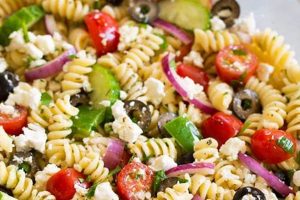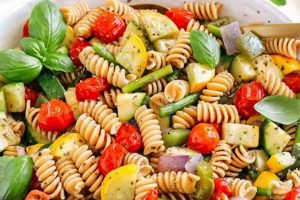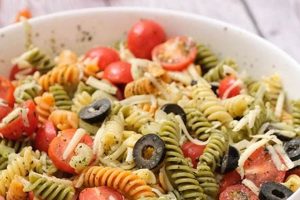A chilled salad combining cooked pasta, typically rotini or other short shapes, with vegetables, cheese, and often cured meats like salami or pepperoni, characterizes this dish. A vinaigrette-style dressing, sometimes creamy, typically binds the ingredients. Variations can include olives, pepperoncini, artichoke hearts, and different cheeses like provolone or mozzarella.
This type of salad offers a convenient and satisfying meal option, combining carbohydrates, protein, and fresh produce. Its adaptability makes it suitable for picnics, potlucks, and quick family dinners. The historical development of this dish likely stems from the increasing popularity of pasta salads in mid-20th century America, influenced by Italian-American cuisine and the growing availability of refrigerated ingredients. Its continued popularity stems from its customizable nature, allowing for adaptations based on dietary preferences and available ingredients.
Exploration of specific ingredient combinations, dressing variations, and techniques for achieving optimal pasta texture and flavor will follow. Detailed instructions and helpful tips will empower readers to create their own delicious versions of this classic dish.
Tips for Crafting an Excellent Pasta Salad
Achieving a well-balanced and flavorful pasta salad requires attention to detail. The following tips offer guidance for creating a dish that is both delicious and visually appealing.
Tip 1: Cook Pasta Properly: Pasta should be cooked al dente, meaning firm to the bite. Overcooked pasta results in a mushy salad. Rinsing the cooked pasta in cold water stops the cooking process and helps maintain a desirable texture.
Tip 2: Select High-Quality Ingredients: Fresh, vibrant vegetables enhance both flavor and appearance. Opt for ripe, in-season produce whenever possible. Consider using high-quality cheeses and cured meats for optimal taste.
Tip 3: Balance Flavors: Strive for a balance of salty, acidic, and sweet elements. This can be achieved through the careful selection of ingredients and the dressing. A touch of sweetness from sun-dried tomatoes or a bit of tang from olives can elevate the overall flavor profile.
Tip 4: Dress Strategically: Add the dressing shortly before serving to prevent the salad from becoming soggy. Toss gently to ensure all ingredients are evenly coated. Consider reserving a portion of the dressing to add just before serving if making the salad in advance.
Tip 5: Chill Thoroughly: Chilling enhances the flavors and allows them to meld. Allow sufficient time for the salad to chill in the refrigerator before serving, ideally for at least an hour.
Tip 6: Consider Ingredient Size: Chop vegetables and other ingredients into bite-sized pieces for easier serving and consumption. Uniformly sized pieces also contribute to a more visually appealing presentation.
Tip 7: Experiment with Variations: Don’t be afraid to customize the salad based on personal preferences or dietary needs. Explore different types of pasta, vegetables, cheeses, and proteins. Consider adding herbs, spices, or nuts for added flavor and texture.
By following these guidelines, one can create a flavorful and satisfying pasta salad suitable for various occasions. Attention to detail, from ingredient selection to proper chilling, contributes to a superior culinary experience.
These tips provide a foundation for creating a successful dish, leading into a detailed recipe and further exploration of variations.
1. Fresh, High-Quality Ingredients
Ingredient quality significantly impacts the overall success of a pasta house salad. Fresh, high-quality components elevate this dish from simple fare to a flavorful, satisfying meal. Selecting optimal produce, cheeses, and meats ensures a delightful sensory experience.
- Produce Vibrancy:
Ripe, in-season vegetables contribute significantly to flavor and texture. Leafy greens should be crisp and unblemished. Tomatoes should be plump and juicy. Compromised produce can lead to a less appealing and potentially unsafe final product. Freshness ensures optimal taste and visual appeal, enhancing the dining experience. For a pasta house salad, consider using romaine lettuce, crunchy bell peppers, and ripe cherry tomatoes for optimal flavor and texture.
- Cheese Selection:
Cheese provides a crucial salty and savory element. Selecting high-quality cheeses, such as fresh mozzarella or provolone, enhances the overall flavor profile. Consider the age and texture of the cheese, opting for varieties that complement the other ingredients. Freshly grated Parmesan offers a sharper, more intense flavor compared to pre-grated alternatives, for instance.
- Cured Meat Quality:
Cured meats like salami, pepperoni, or ham contribute a savory, salty dimension. Quality matters here. Look for meats with a deep color and pleasant aroma. Avoid products with excessive fat or artificial coloring. High-quality cured meats offer a richer, more authentic flavor, enhancing the complexity of the salad.
- Dressing Enhancement:
While not a primary ingredient, the dressing interacts directly with the other components. A high-quality vinaigrette, made with fresh herbs, spices, and good quality oil and vinegar, will amplify the flavors of the produce and other ingredients. A homemade dressing allows for control over sodium content and flavor profiles, further enhancing the final product.
Prioritizing fresh, high-quality ingredients elevates the pasta house salad, transforming it into a more flavorful and satisfying experience. The interplay of fresh produce, carefully selected cheese, and quality cured meats, combined with a vibrant dressing, results in a well-balanced and enjoyable culinary creation. The attention to ingredient quality contributes significantly to the dish’s overall success.
2. Perfectly Cooked Pasta
Achieving perfectly cooked pasta is paramount to a successful pasta house salad recipe. The pasta’s texture significantly influences the overall enjoyment of the dish. Overcooked pasta becomes mushy and absorbs excessive dressing, leading to a heavy, unappetizing salad. Undercooked pasta, conversely, presents a tough, unpleasant texture that detracts from the other ingredients. The ideal pasta for this salad offers a delicate balance: tender yet firm to the bite, often referred to as al dente.
This optimal texture provides a pleasant chewiness that complements the crispness of the vegetables and the richness of the other components. Consider the difference between a salad featuring mushy overcooked rotini and one with perfectly al dente rotini. The former results in a dense, clumpy salad where the pasta dominates, while the latter allows the individual flavors and textures of the vegetables, cheeses, and meats to shine. Properly cooked pasta also absorbs the dressing more evenly, distributing the flavor throughout the salad without becoming soggy. For instance, a pasta salad with perfectly cooked farfalle will hold its shape and texture even after being dressed, while overcooked farfalle will break down and become sticky.
Understanding the impact of pasta texture underscores its importance in the overall recipe. Cooking pasta al dente ensures a balanced, enjoyable salad where each ingredient contributes positively to the final product. This attention to detail elevates the pasta house salad from a simple side dish to a satisfying, flavorful meal. Challenges may arise when cooking different pasta shapes, as cooking times vary. Consulting package directions and testing for doneness regularly prevents overcooking. This dedication to proper pasta preparation lays a solid foundation for a successful pasta house salad experience.
3. Vibrant, Balanced Dressing
The dressing serves as a unifying element in a pasta house salad recipe, binding the individual components and influencing the overall flavor profile. A vibrant, balanced dressing enhances, rather than masks, the flavors of the pasta, vegetables, cheeses, and meats. It provides a crucial counterpoint to the other ingredients, adding brightness, acidity, and depth.
- Acidity as a Flavor Enhancer
Acidity, often derived from vinegar or citrus juice, plays a crucial role in balancing the richness of the other ingredients. It brightens the flavors and provides a refreshing counterpoint to the heavier elements like cheese and cured meats. For example, a lemon vinaigrette cuts through the richness of provolone and salami, preventing the salad from feeling too heavy. The right level of acidity stimulates the palate and elevates the overall sensory experience. Too much acidity can be overpowering, while too little can result in a bland, one-dimensional salad.
- Oil for Texture and Flavor
Oil contributes to the dressing’s texture and mouthfeel, providing a smooth, lubricating quality. It also carries and distributes flavors throughout the salad. Extra virgin olive oil, with its fruity and peppery notes, is a popular choice. The oil also helps to coat the pasta and vegetables, preventing them from drying out and ensuring an even distribution of flavor. Choosing a high-quality oil enhances the overall flavor profile and contributes to a more satisfying culinary experience. The ratio of oil to vinegar influences the dressing’s consistency and flavor intensity.
- Seasoning for Depth and Complexity
Seasoning, encompassing herbs, spices, and salt and pepper, adds depth and complexity to the dressing. Fresh herbs like oregano, basil, or parsley provide a burst of fresh flavor, while dried herbs like Italian seasoning offer a more concentrated, robust taste. Garlic and onion powder can add savory notes. Balancing the seasoning ensures that no single flavor dominates while complementing the overall flavor profile. Over-seasoning can mask the delicate flavors of the other ingredients, while under-seasoning can lead to a bland and uninspired salad.
- Emulsification for Stability and Consistency
Emulsification refers to the process of combining oil and vinegar into a stable mixture. A properly emulsified dressing clings to the other ingredients, ensuring an even distribution of flavor. A vinaigrette that separates quickly can lead to an unevenly coated salad with pockets of excessive oil or vinegar. Emulsification can be achieved by whisking the dressing vigorously or using an emulsifying agent like Dijon mustard. This creates a harmonious blend of flavors and textures.
A well-crafted dressing elevates the pasta house salad, transforming it from a simple combination of ingredients into a cohesive and flavorful dish. The balance of acidity, oil, seasoning, and emulsification ensures that the dressing complements the other components, creating a symphony of flavors and textures that delight the palate. This careful attention to the dressing is a key differentiator between an average pasta salad and a truly exceptional one.
4. Appropriate Chilling Time
Appropriate chilling time plays a crucial role in the final quality of a pasta house salad recipe. Chilling is not merely a matter of food safety; it directly impacts flavor development and ingredient cohesion. Insufficient chilling can result in a bland, disjointed salad, while excessive chilling can negatively affect the texture of certain ingredients. Understanding the optimal chilling duration is essential for maximizing the dish’s potential.
- Flavor Melding
Chilling allows the flavors of the various ingredientspasta, vegetables, cheese, meats, and dressingto meld and harmonize. The flavors deepen and integrate, creating a more complex and nuanced flavor profile. This process is akin to marinating, where time allows the ingredients to absorb and exchange flavors. For example, the sharpness of the vinegar in the dressing mellows and integrates with the sweetness of the vegetables and the saltiness of the cheese and meat. A freshly made pasta salad often tastes brighter and more disjointed compared to one that has been properly chilled.
- Texture Enhancement
Chilling firms the pasta and vegetables, enhancing their textures and creating a more pleasing mouthfeel. The cold temperature also solidifies the fats in the dressing, contributing to a richer, more cohesive texture. For instance, chilled pasta holds its shape better, preventing it from becoming mushy, while chilled vegetables retain their crispness. However, excessive chilling can make some vegetables, like tomatoes, lose their flavor and become mealy.
- Food Safety Considerations
Chilling inhibits bacterial growth, ensuring food safety, especially in salads containing perishable ingredients like mayonnaise-based dressings or cured meats. Prompt and adequate chilling is crucial to minimize the risk of foodborne illness. Maintaining a refrigerator temperature of 40F (4C) or below is essential for safe food storage. Leaving a pasta salad at room temperature for extended periods, especially in warm environments, can create a breeding ground for harmful bacteria.
- Optimal Chilling Duration
While the ideal chilling time varies depending on the specific ingredients and dressing, a general guideline is to refrigerate the pasta salad for at least one hour before serving. This allows sufficient time for flavor melding and texture enhancement without compromising the quality of delicate ingredients. For optimal flavor development, chilling for up to four hours is recommended, but avoid exceeding this timeframe, particularly if using fresh tomatoes or other ingredients sensitive to prolonged cold exposure. This ensures a balance between flavor development and textural integrity.
The appropriate chilling time is an integral step in creating a successful pasta house salad recipe. By allowing the flavors to meld, textures to firm, and ensuring food safety, proper chilling elevates this dish from a simple mixture of ingredients to a cohesive, flavorful, and safe culinary creation. Understanding the nuances of chilling time contributes significantly to the overall enjoyment and quality of the pasta house salad experience.
5. Flavorful additions (meats, cheeses)
Flavorful additions, primarily cured meats and cheeses, distinguish a basic pasta salad from a robust, satisfying “pasta house salad.” These additions contribute significantly to the overall sensory experience, providing savory depth, textural complexity, and visual appeal. Their strategic inclusion elevates the dish from a simple side to a more substantial meal.
- Cured Meats: Enhancing Savory Depth
Cured meats like salami, pepperoni, and prosciutto introduce a salty, savory dimension. These ingredients offer a concentrated flavor profile that complements the other components. Salami’s fermented tang provides a pleasant contrast to sweeter elements like bell peppers or tomatoes. Pepperoni’s smoky spice adds a layer of complexity. Prosciutto, with its delicate saltiness, provides a more refined savory note. The choice of cured meat influences the overall taste profile, allowing for customization based on preference.
- Cheeses: Contributing Richness and Texture
Cheeses introduce richness, creaminess, and textural variation. Mozzarella, with its mild, milky flavor and soft texture, offers a classic pairing. Provolone, slightly sharper and firmer, provides a more robust presence. Parmesan, grated or shaved, adds a salty, umami punch. The cheese selection should complement the other ingredients and the chosen dressing. For instance, a strongly flavored cheese might overpower a delicate vinaigrette. Cubed, shredded, or crumbled cheese provides varying textural experiences.
- Balancing Flavors and Textures
The selection and proportion of flavorful additions contribute significantly to the overall balance. A delicate balance between cured meats and cheeses prevents any single flavor from dominating. Consider the interplay of textures the chewiness of salami against the creaminess of mozzarella, or the crisp snap of pepperoni against the crumbly texture of feta. This interplay adds a dynamic element to each bite. Overloading the salad with these additions can make it heavy and overly rich, while too little can leave it lacking in depth and character.
- Visual Appeal and Presentation
Flavorful additions enhance the visual appeal of the pasta house salad. The vibrant red of pepperoni, the marbled texture of salami, and the stark white of mozzarella create visual interest against the backdrop of colorful vegetables and pasta. Careful arrangement of these elements can elevate the presentation from a simple toss to a more visually engaging dish. This visual appeal stimulates appetite and contributes to a more enjoyable dining experience.
The strategic incorporation of flavorful additionscured meats and cheesesis essential for achieving the characteristic depth and complexity of a pasta house salad. These additions, when carefully selected and balanced, elevate the dish beyond a simple pasta salad, creating a more substantial, flavorful, and visually appealing meal. Their contribution extends beyond mere flavor enhancement, influencing texture, visual appeal, and overall satisfaction.
Frequently Asked Questions
This section addresses common inquiries regarding pasta house salad preparation, offering practical guidance for optimal results.
Question 1: What type of pasta is best suited for this salad?
Short, sturdy pasta shapes like rotini, farfalle, or penne hold their shape well and capture dressing effectively. Longer strands, such as spaghetti or linguine, can become unwieldy and difficult to eat in a salad context.
Question 2: Can the salad be prepared in advance?
Advance preparation is possible, but adding the dressing immediately before serving is recommended to prevent the salad from becoming soggy. Store the dressed and undressed components separately and combine just prior to serving.
Question 3: How long can the salad be stored?
Properly refrigerated, the salad can be stored for up to three days. However, the quality and texture may begin to decline after the first day, particularly if using fresh vegetables prone to wilting.
Question 4: What are suitable vegetarian alternatives to cured meats?
Roasted vegetables, such as bell peppers, zucchini, or eggplant, can provide a flavorful and texturally satisfying vegetarian alternative. Marinated artichoke hearts or olives can also add a savory dimension.
Question 5: How can one reduce the sodium content?
Using low-sodium or no-salt-added ingredients, such as cured meats, cheeses, and olives, can significantly reduce sodium content. Homemade dressings allow for greater control over sodium levels compared to store-bought options.
Question 6: Can other vegetables be included?
Flexibility in vegetable selection is encouraged. Consider cucumbers, carrots, celery, red onion, or other vegetables that complement the chosen flavors and textures. Blanching certain vegetables, like broccoli or cauliflower, can enhance their flavor and texture in the salad.
Addressing these common questions provides a more thorough understanding of pasta house salad preparation, paving the way for culinary success. Careful consideration of these points ensures an enjoyable and satisfying culinary experience.
This FAQ section offers valuable insights into the nuances of creating a delicious pasta house salad. Next, a detailed recipe will provide step-by-step instructions for crafting this culinary delight.
Pasta House Salad Recipe
Exploration of the pasta house salad recipe reveals a dish greater than the sum of its parts. Careful consideration of ingredient quality, pasta texture, dressing vibrancy, chilling time, and flavorful additions distinguishes a truly exceptional salad from a mediocre one. Fresh, crisp vegetables, perfectly cooked al dente pasta, and a balanced, flavorful dressing form the foundation. Cured meats and cheeses contribute savory depth and richness, while appropriate chilling allows flavors to meld harmoniously. Attention to these details elevates the dish from a simple side to a satisfying, flavorful meal.
The adaptability of this recipe offers opportunities for culinary exploration. Adapting ingredients based on seasonal availability and personal preferences allows for continuous reinvention. Mastering the foundational elements empowers culinary enthusiasts to create personalized versions, ensuring the pasta house salad remains a timeless and versatile culinary staple.






